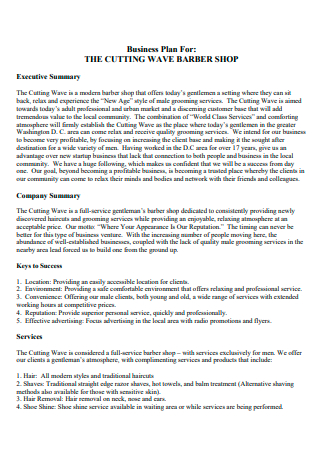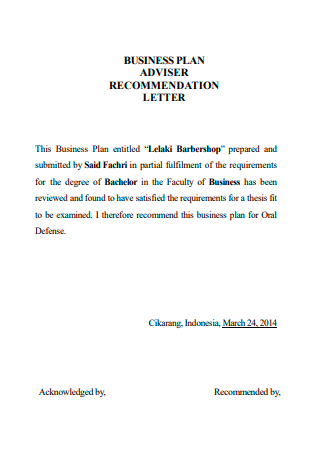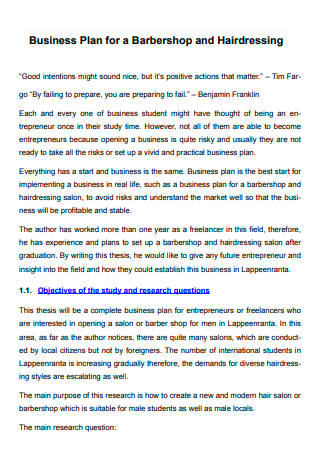3+ Sample Barber Shop Business Plan
FREE Barber Shop Business Plan s to Download
3+ Sample Barber Shop Business Plan
What Is a Barber Shop Business Plan?
Why Choose a Barber Shop for a Business?
Making That Successful Barber Shop Business Plan
FAQs
What are some of the services that are typically offered in a barber shop?
What are some of the common men’s haircuts offered in a barber shop?
What are some of the tools and equipment usually found in a barber shop?
What Is a Barber Shop Business Plan?
A barber shop is a place where people, especially the men, would go to get a haircut, a hair trim, or have their hair styled. A barber shop business plan is a documented written work detailing the process of how a barber shop goes about achieving its operational, financial, and marketing goals. Business plans oftentimes serve as a roadmap that includes strategic action steps, starting from day 1 of a business’s operation. New barber shop startups often use a business plan as a presentation to financial lending institutions or potential investors to secure capital funding. To get a sign-off and a yes from its potential investors, barber shops needed to prove and show that there is a current need for their business in the market. Their business plan should be logical and should show the feasibility and viability of the business. It should also be transparent, outlining the risks, and at the same time, preparing contingency plans in place. A lot goes into the making of a barber shop business plan, but the benefits are far greater than having a business with no plan at all.
Why Choose a Barber Shop for a Business?
Aside from the obvious passion for hairstyles and haircuts, there are a lot of other reasons why having a barber shop is one of the best choices for putting up a business. When you think about barber shops, there is a certain age-old appeal to it that attracts customers of all ages to come and to spend more time in the shops than as necessary. Typically, 90% of a barber shop’s customers are men, but it doesn’t mean that women can’t avail themselves of their services. Barbers are generally trained to do shorter hairs using clippers, razors, the no-nonsense men’s hairstyle approach. But of all the businesses out there, including a salon business, why put up a barber shop instead?
Making That Successful Barber Shop Business Plan
A successful business is a result of successful planning. The same applies to a barber shop business. Although the business model used is pretty straightforward, still, if the owner wanted to have a barber shop that’s blooming, thriving, and the next big thing, a lot of thought processes should go into coming up with a business plan. A business plan does more than just outline the steps needed to be taken in operating a business; it provides clarity when making decisions, showing the pros and cons of each strategy. More importantly, it provides transparency, especially when it comes to the financial aspects of the business. There are a lot of formats that you can use when creating a barbershop business plan. What’s important is that the core elements are included in the making of a business plan.
Step 1: Executive Summary
An Executive Summary provides the outline of the business’s purpose and goals. It gives a short overview look into the target market, the market’s condition, the business opportunity, as well as the marketing strategy and the financial highlights of the business. The executive summary also includes a brief history of the business and a mission statement. The Mission Statement should state the purpose and goals for putting up a barbershop business. It is also a reflection of the business’s culture and values and should inspire and motivate its reader.
Step 2: Market Analysis
A Market Analysis is a study done on the current market’s condition. It looks into if there is a need for a particular product or service, and also provides supporting proof for a business opportunity. It also includes doing a customer analysis. Customer analysis is done through target market segmentation, by dividing the customers according to demographic classifications such as age, gender, location, income, lifestyle, et cetera. A competition analysis is also made. Oftentimes when studying the market, the SWOT Analysis is applied.
In a barber shop business plan, SWOT analysis refers to the Strength of the business, meaning, what are the qualities that made it stand out and unique; Weaknesses, the factors that are limiting the growth and success of the shop, such as lack of funding, lack of manpower, weak marketing strategy; Opportunities are those aspects that the shop could take advantage of to further its success, as the use of social media platform to advertise, hiring an influencer to promote the shop, et cetera; Threats are those that could potentially harm the business, for instance, the increasing presence of competing barbershops within proximity, an increase of building rental fees, and even unforeseeable circumstances, such as a health crisis like the current pandemic.
Step 3: Marketing Plan
The purpose of having a Marketing Plan is to increase target market leads through marketing and sales strategies. Writing out a marketing plan for a barber shop involves creating a goal and a timeline. It should lay out the foundation of what is the goal, the purpose, and when it should be achieved. The marketing strategies and the sales strategies provide the support the marketing plan needs through identified action items. A Marketing Strategy is the “how-to” process of achieving the business’s desired goal. For barber shops, a marketing strategy could be an increased presence in social media or social networking platforms as an advertising campaign.
Another example would be promotional offerings, such as offering value-added services, like free shave for every haircut availed, or free massage or shoe shine while waiting customers are waiting for their turn. Another marketing strategy could be promoting a new haircut or promoting the skills of their barbers that could achieve the looks of those A-list red carpet celebrities. A Sales Strategy supports and implements the marketing strategy through properly positioning the business in the market. While the marketing strategy is generally focused on creating customer leads, sales strategy is all about the ways of generating the revenue stream. For social media advertising, a sales strategy creates engaging content that makes the reader click on the link of the offered promotion, or else head to that barber shop to avail their services. Another sales strategy is hiring influencers to promote the shop through their popular channel platforms.
Step 4: Financial Plan
The Financial Plan section provides the financial health outlook of the barber shop business. It shows how viable or feasible the barber shop business plan is. A financial plan typically includes a balance sheet, that shows the assets, liabilities, and equity of the business; a profit and loss statement, which shows how the barber shop is making its profit, versus the actual or estimated costs and expenses; as well as a sales forecast, a revenue projection stemming from the marketing and sales strategies. Future investors, or lending institutions, wanted to see the actual financial condition of the business, as well as if the sales forecasts are realistic and measurable. Meaning, the forecast has more than a 50% chance of the profit being realized. A financial plan is also a guide for the barber shop owner to keep track of the revenue stream, using it as a basis to make some revisions in the marketing plans as necessary.
FAQs
What are some of the services that are typically offered in a barber shop?
Services offered include haircut (cut, styling, color, highlights, and scalp treatments), shaves with hot towels, manicures and pedicures, waxing, facial treatment, massages, hair removal, hair braiding, shoeshine, and so on.
What are some of the common men’s haircuts offered in a barber shop?
Oftentimes when you walk into a barber shop for a haircut, you already have a style in mind of what you wanted to look like. It is important to be familiar with the barber who’s doing your hair, or else you’d go for the next barber who has an established reputation of achieving the haircut that customers wanted. Nevertheless, here are some of the common haircuts offered in a barber shop: the Buzz Cut, a classic, all the way clean-cut short hairstyle; the Quiff Cut, the significant bushy mop-top hair, with shorter trim at the sides and back; the Crew Cut, a popular cut for those in the army, featuring shaved sides, while the top part left just a little bit longer; and the stylish Pompadour Cut, featuring swept up and back long hair.
What are some of the tools and equipment usually found in a barber shop?
Having the right tools and equipment is what creates the magic in a barber shop. More than just having sharp scissors and razor blades, barbers rely on having the right tools to achieve the outcome that their customers wanted. For a barber shop to be successful, it needs to have the right tools and equipment in place that’s definitive of a place where men, or women, can go for their haircuts and hairstyles. Some of these tools and equipment are barber chairs, hair clippers, hair trimmers, edgers, barber shears, barber comb, straight razors, hairdryers, hair products, shaving creams, disinfectants, and so on.
Who wouldn’t want to look like they’re ready for the red carpet once they come out of a barber shop? Wouldn’t you want a hairdo, sporting the same one as David Beckham’s? Honestly speaking, is that even possible? It certainly is! That’s the magic that your barber works on you, to create that look that’s similar to your favorite Hollywood A-lister! That’s what barber shops offer to their customers. Barber shops aim to be the place where people, especially men, could go to get that look that’s straight out of the ads. Or, they simply wanted their customers to come and enjoy and be pampered with all of the services that they offer in their shops. And that’s all laid out in a well-crafted barber shop business plan.
Needing help in making that effective barber shop business plan? Check out our barber shop business plan templates. They’re so easy to fill out, and you can easily download and use them as a guide to running your barber shop business. So, what are you waiting for? Download one now, and see your barber shop blooming and thriving!




